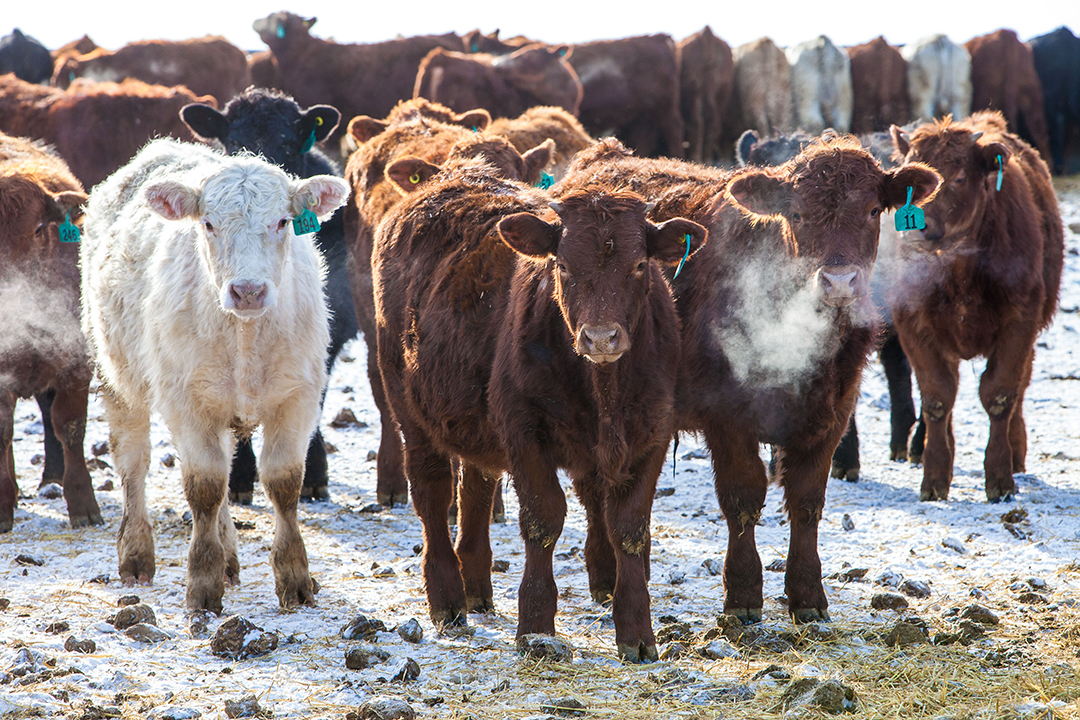
Time is money: rapid diagnostic testing for bovine respiratory disease
A multidisciplinary research team is working to develop rapid genomic testing methods that will change the way feedlots make decisions about antimicrobial use and ultimately improve antimicrobial stewardship.
By Morgan LehmannBovine respiratory disease (BRD), more commonly known among cattle producers as shipping fever, is the leading cause of disease and death in North American feedlots.
Although feedlot veterinarians and managers currently rely on clinical history and symptoms to diagnose or assign a level of risk for BRD, those clinical symptoms don’t identify the specific pathogen (disease agent) causing the disease. Clinical signs also don’t indicate whether the pathogen contains genes that make it resistant to antimicrobial treatments.
The current diagnostic tests that can potentially answer those questions require up to a week of processing time, meaning that veterinarians often prescribe antimicrobial drugs without a specific diagnosis. There is pressure to provide diagnostic information to prescribe antimicrobials in order to demonstrate antimicrobial stewardship.
“Stewardship for antimicrobials is using the right drug in the right patients at the right time for the right reasons,” says Dr. Simon Otto, an assistant professor at the University of Alberta School of Public Health and a 2002 graduate of the Western College of Veterinary Medicine (WCVM).
Otto and Dr. Cheryl Waldner, a WCVM professor and the NSERC/BCRC Beef Cattle Research Council Senior Industrial Research Chair, are co-leaders of Genomic ASSETS (Antimicrobial Stewardship Systems from Evidence-Based Treatment Strategies) for Livestock, a $5.6-million-dollar project aimed at providing more timely diagnostic information for feedlot cattle to support antimicrobial stewardship.
By developing rapid testing technology that can identity respiratory pathogens and any antimicrobial resistance in calves entering feedlots, they aim to inform group-level, precision antibiotic treatment.
After calves are weaned from their mothers, they’re sent to feedlots where they’re fed until they reach optimal slaughter condition. During transportation and upon their arrival at feedlots, these calves co-mingle with animals from other farms and ranches — a practice that exposes them to new bacteria and viruses. Changes in environment and management settings also stress the calves and can trigger a compromised immune system response.
“To give a comparison, it's similar to kids in a daycare,” says Otto. “When you take them to daycare or school in the fall, you add the stress of a new classroom and mix them with a bunch of other kids where they spread around the respiratory bugs and get sick. In the feedlot, if we could test a handful of calves when they enter the feedlot and figure out what bacteria or viruses and potential resistance they have, we could use that to direct antimicrobial treatment when they get sick a week or two down the road.”
Otto emphasizes that the rapid genomic tests aren’t capable of immediate, point-of-care diagnoses for sick animals at this time. However, the tests will be used to establish pen-level baseline information that can guide future antimicrobial treatments for BRD infections. Feedlot veterinarians and managers can then review that data when choosing an appropriate antimicrobial drug.
“With Genomic ASSETS, our goal is to get to a place where we can tailor the antimicrobial drug selection based on detection of resistance patterns so that we can reduce ineffective treatments and minimize the chance of selection for resistance,” Otto explains.
The Genomic ASSETS team is also focused on keeping their project practical and relevant. A large part of Otto’s role involves industry engagement and work with researchers at the U of A to analyze the economic implications of a production system that is informed by diagnostic testing.
“We actually want to engage with the feedlot industry and feedlot veterinarians to understand and make sure that the system we're designing is going to be practical and usable for them,” says Otto.
Besides improving antimicrobial stewardship in the beef industry, rapid diagnostic testing may be key to accessing international markets and keeping antibiotics as a valuable tool for livestock husbandry.
“The international landscape for antimicrobial stewardship is changing for animal agriculture,” says Otto. “Potential legislative changes in the European Union could require diagnostic testing to justify the use of certain antimicrobials. In other words, if we don't have a diagnostic test to support their use, we might not be able to access certain antimicrobial drugs for livestock.”
If diagnostic testing becomes a regulatory requirement for antimicrobial administration, the work of Genomic ASSETS for Livestock will be crucial for navigating the changing industry practices.
“We see the rapid genomic methods and bioinformatics integration as platforms that will be applicable to other diseases in beef cattle and other livestock industries,” says Otto. “We see this as a platform that can be rolled out for diseases in other industries.”
Morgan Lehmann of Rosthern, Sask., is a third-year animal science student in the USask College of Agriculture and Bioresources. Morgan joined the Genomic ASSETS team as a summer research student in 2021, working with Drs. Simon Otto and Cheryl Waldner. Morgan stayed on as a research assistant in Dr. Waldner’s lab during the 2021-22 academic year and is continuing her work with the Genomic ASSETS team as a summer research student in 2022.